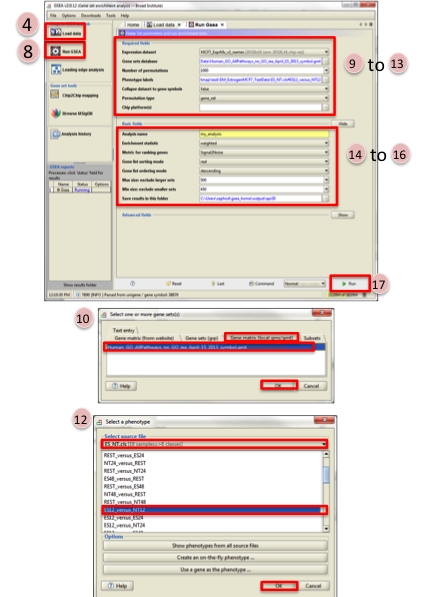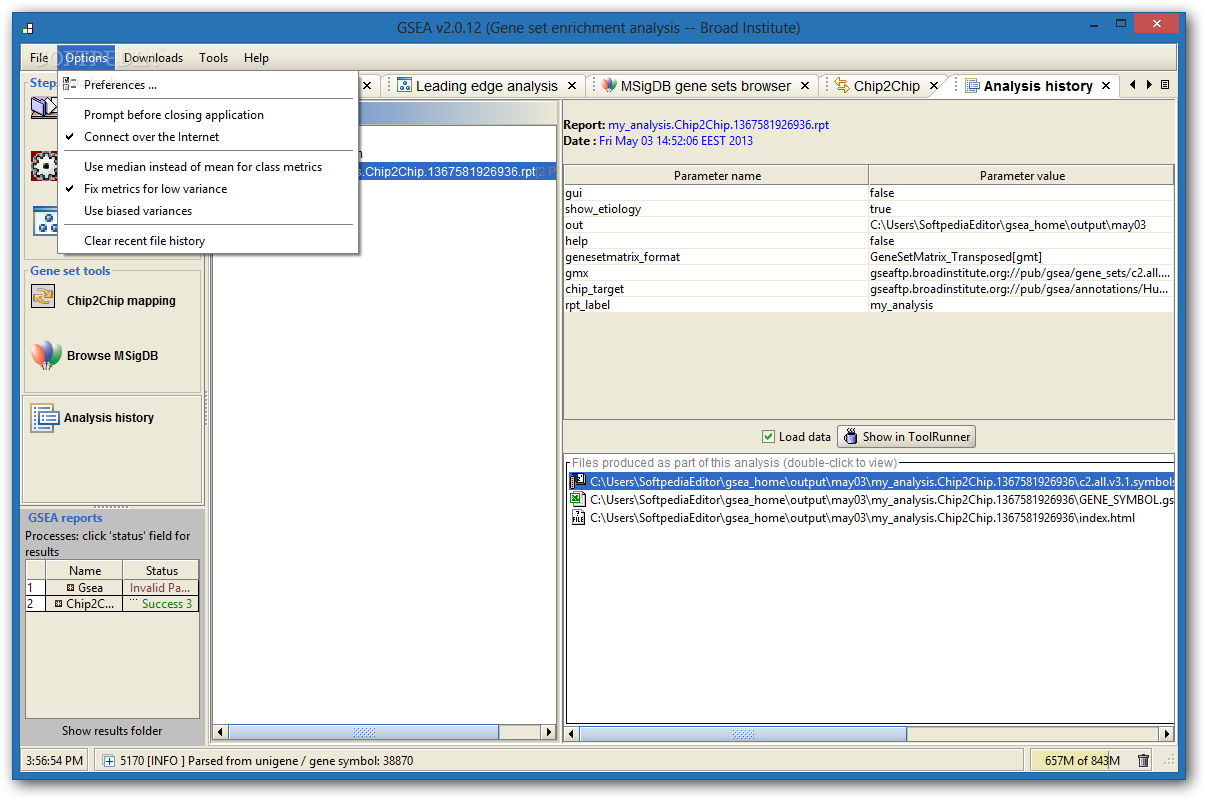1) Install latest version of R which can be downloaded from http://probability.ca/cran/.
Download Gene Set Enrichment Analysis for free. Gene Set Enrichment Analysis (GSEA) is a computational method that determines whether an a priori defined set of genes shows statistically significant, concordant differences between two biological states. There is a known issue on Mac where sometimes selecting a value in the Compress: combo box has no effect. The workaround is to click on the combo box with the mouse, hold down the mouse button, hover the mouse pointer over the option you want, and then release the button.
1b) Download and install the most recent version of R Studio desktop. If prompted to install git, select yes.

2) Install the BioConductor core packages. If you have installed R version 3.5.0 or higher, open R and at the ‘>' prompt, paste the commands:
If you already have an older version of R installed (3.4.4 or lower), open R and at the ‘>' prompt, paste the commands:
If you are unsure which version you have installed, open R and at the ‘>' prompt, enter the command:
3) A robust text editor.
- For Windows/PC - notepad++
- For Linux - gEdit
- For Mac – TextWrangler
4) A file decompression tool.

- For Windows/PC – 7zip.
- For Linux – gzip.
- For Mac – already there.
5) A robust internet browser such as Firefox or Safari (Internet Explorer and Chrome are not recommended because of Java issues).
6) Java -The visualization program that we will be using (IGV) requires Java. Check if you have Java installed: https://www.java.com/verify/ and download Java if you do not have it installed (You need Java 8. Do NOT install Java 10).
7) Integrative Genomics Viewer 2.4 (IGV) - Once java is installed, go to http://www.broadinstitute.org/igv/ and register in order to get access to the downloads page. Once you have gained access to the download page, click on the appropriate launch button that matches your computer's operating system
8) SSH client - Mac and Linux users already have a command line ssh program that can be run from the terminal. Microsoft excel 2013 download free. For Windows users, please download PuTTY.
9) SCP/SFTP client - We will be moving data from the servers to the student laptops for visualization. Mac and Linux users already have a command line scp and sftp program. For Windows users, please install WinSCP.
10) A PDF viewer (Adobe Acrobat or equivalent).
12) Install Cytoscape 3.7.1.
Choose the version corresponding to your operating system (OS, Windows or UNIX) Cytoscape requires Java8: check your version at https://www.java.com/verify/ and download Java8 if you do not have it installed. Contact your system administrator if you have trouble with Java installation.
13) Within the Cytoscape program, install the following Cytoscape apps.
From the menu bar, select ‘Apps', then ‘App Manager'.

Within ‘all apps', search for the following and install:
- EnrichmentMap (3.2.0)
- EnrichmentMap Pipeline Collection (it will install ClusterMaker2, WordCloud and AutoAnnotate)
- GeneMANIA (3.5.0)
- Iregulon
- ReactomeFIPlugin - http://apps.cytoscape.org/apps/reactomefiplugin
- stringApp
14) Install the data set within GeneMANIA app.
From the menu bar, select ‘Apps', hover over ‘GeneMANIA', then select ‘Choose Another Data Set'.
From the list of available data sets, select the most recent (2017-07-13/13 July 2017) and under ‘Include only these networks:' select ‘all'. Click on ‘Download'.
An ‘Install Data' window will pop-up. Select H.Sapiens Human (2589 MB). Click on ‘Install'.
This requires time and a good network connection to download completely, so be patient (around 15mins).
Gsea Gene Set Database
15) Install GSEA.
Go to the GSEA page
Register
Login
In menu, choose Downloads
Go to the javaGSEA Java Jar file section and download the gsea-3.0.jar file and save in your Documents folder (do not leave it in the 'Downloads'folder).
To run GSEA during the workshop, you must use the command line. You will need to open a terminal and execute the install commands. Since we will need to run GSEA this same way each time, it will be a good idea to save this information on how to run GSEA.
MAC/Linux Computer
Gsea Install
- On a MAC, the Terminal window is located in Applications/Utilities. Tip: add the terminal window to your dock so it is easy to open when needed.
- At the prompt, type the command in your terminal window and hit enter:

2) Install the BioConductor core packages. If you have installed R version 3.5.0 or higher, open R and at the ‘>' prompt, paste the commands:
If you already have an older version of R installed (3.4.4 or lower), open R and at the ‘>' prompt, paste the commands:
If you are unsure which version you have installed, open R and at the ‘>' prompt, enter the command:
3) A robust text editor.
- For Windows/PC - notepad++
- For Linux - gEdit
- For Mac – TextWrangler
4) A file decompression tool.
- For Windows/PC – 7zip.
- For Linux – gzip.
- For Mac – already there.
5) A robust internet browser such as Firefox or Safari (Internet Explorer and Chrome are not recommended because of Java issues).
6) Java -The visualization program that we will be using (IGV) requires Java. Check if you have Java installed: https://www.java.com/verify/ and download Java if you do not have it installed (You need Java 8. Do NOT install Java 10).
7) Integrative Genomics Viewer 2.4 (IGV) - Once java is installed, go to http://www.broadinstitute.org/igv/ and register in order to get access to the downloads page. Once you have gained access to the download page, click on the appropriate launch button that matches your computer's operating system
8) SSH client - Mac and Linux users already have a command line ssh program that can be run from the terminal. Microsoft excel 2013 download free. For Windows users, please download PuTTY.
9) SCP/SFTP client - We will be moving data from the servers to the student laptops for visualization. Mac and Linux users already have a command line scp and sftp program. For Windows users, please install WinSCP.
10) A PDF viewer (Adobe Acrobat or equivalent).
12) Install Cytoscape 3.7.1.
Choose the version corresponding to your operating system (OS, Windows or UNIX) Cytoscape requires Java8: check your version at https://www.java.com/verify/ and download Java8 if you do not have it installed. Contact your system administrator if you have trouble with Java installation.
13) Within the Cytoscape program, install the following Cytoscape apps.
From the menu bar, select ‘Apps', then ‘App Manager'.
Within ‘all apps', search for the following and install:
- EnrichmentMap (3.2.0)
- EnrichmentMap Pipeline Collection (it will install ClusterMaker2, WordCloud and AutoAnnotate)
- GeneMANIA (3.5.0)
- Iregulon
- ReactomeFIPlugin - http://apps.cytoscape.org/apps/reactomefiplugin
- stringApp
14) Install the data set within GeneMANIA app.
From the menu bar, select ‘Apps', hover over ‘GeneMANIA', then select ‘Choose Another Data Set'.
From the list of available data sets, select the most recent (2017-07-13/13 July 2017) and under ‘Include only these networks:' select ‘all'. Click on ‘Download'.
An ‘Install Data' window will pop-up. Select H.Sapiens Human (2589 MB). Click on ‘Install'.
This requires time and a good network connection to download completely, so be patient (around 15mins).
Gsea Gene Set Database
15) Install GSEA.
Go to the GSEA page
Register
Login
In menu, choose Downloads
Go to the javaGSEA Java Jar file section and download the gsea-3.0.jar file and save in your Documents folder (do not leave it in the 'Downloads'folder).
To run GSEA during the workshop, you must use the command line. You will need to open a terminal and execute the install commands. Since we will need to run GSEA this same way each time, it will be a good idea to save this information on how to run GSEA.
MAC/Linux Computer
Gsea Install
- On a MAC, the Terminal window is located in Applications/Utilities. Tip: add the terminal window to your dock so it is easy to open when needed.
- At the prompt, type the command in your terminal window and hit enter:
Gsea Mouse Gene Set
PC/Windows Computer
- On Windows, go to the start icon and type cmd (for command prompt) in the search box.
- At the prompt, type the following commands, hitting enter in between each command and waiting for the prompt before the next command:
